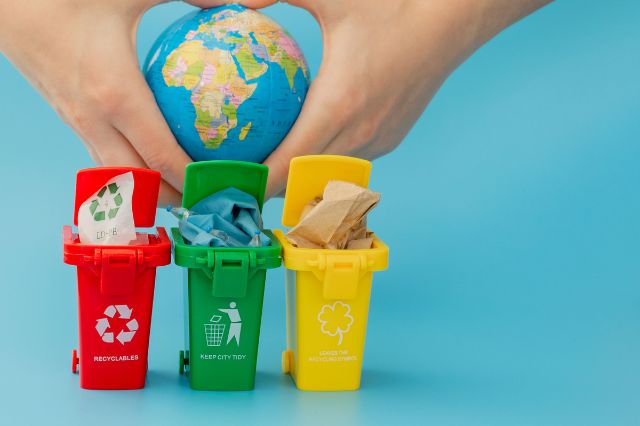Today in a world largely dominated by the impetus usage of single-use plastics, reckless dependency on the ostensibly infinite energy sources and the perennial wastage of water, we are collectively paving our way towards obliteration.
Human activities have led to severe environmental crises, with one million species at risk of extinction, 40 percent of the planet’s soil degraded, one in three people facing water scarcity, 2.8 billion exposed to hazardous air pollution with annual health costs reaching 8.1 trillion dollars, 14 million tons of plastic entering oceans each year, and 7.5 trillion tons of Antarctic ice lost, threatening up to 480 million coastal residents.
These alarming statistics have seemed to have no impact on the apparently impervious human race even though the loss of biodiversity, soil degradation, water scarcity, and air pollution threaten agriculture, food security, resource availability, public health, and economic productivity, increasing vulnerability to climate change and potential conflicts.
In the eyes of many, world change may be a longshot, but taking small steps isn’t necessarily an unattainable feat provided one really is committed to bringing about impactful change in our planet.
So to break down this effort, HelpLocal presents a guide to 30 eco-friendly practices to help our environment!
Reduce, Reuse, Recycle
Reduce single-use plastics – Carry reusable bags, bottles, and cutlery to minimize plastic waste. Single-use plastics take hundreds of years to decompose and harm marine life. Choose biodegradable or compostable alternatives whenever possible. Read more about reducing plastic waste here. [Insert Link]
Recycle properly – Learn local recycling rules to ensure items are disposed of correctly. Contaminated recycling can ruin entire batches, sending them to landfills. Rinse containers and sort recyclables accordingly.
Compost food waste – Convert food scraps into natural fertilizer instead of sending them to landfills. Composting reduces methane emissions and improves soil health. You can compost fruit peels, vegetable scraps, and coffee grounds.
Donate or repurpose old clothes – Instead of discarding old clothes, donate them to charities or upcycle them into new items. Fast fashion creates enormous waste and pollution. Thrift shopping and clothing swaps also reduce demand for new production.
Choose products with minimal or biodegradable packaging – Avoid excessive plastic wrapping and opt for items with recyclable or compostable materials. Many brands now offer refill stations to cut down on waste. Buying in bulk also reduces packaging waste.

Save energy
Use LED bulbs – LEDs use up to 80% less energy and last much longer than traditional incandescent bulbs. This reduces electricity consumption and lowers your carbon footprint. They also produce less heat, making them safer.
Unplug electronics when not in use – Many devices consume power even when turned off, known as “phantom energy.” Unplug chargers, appliances, and devices to prevent unnecessary electricity waste. Using power strips makes this easier.
Switch to renewable energy sources – Solar, wind, and hydroelectric power generate electricity with minimal environmental impact. Installing solar panels can save money in the long run. Even switching to a green energy provider can help.
Use energy-efficient appliances – Appliances with high Energy Star ratings consume less electricity. They reduce energy bills and help minimize your environmental impact. Look for labels and choose energy-efficient options when replacing old appliances.
Air-dry clothes – Using a dryer consumes a lot of electricity, whereas air drying saves energy and extends clothing lifespan. Sunlight naturally disinfects clothes and keeps fabrics fresh. Invest in drying racks if space is limited.

Conserve water
Turn off taps while brushing teeth or washing dishes – Running water unnecessarily wastes liters of clean water daily. Simply turning off the tap while brushing can save up to 4 gallons per minute. Small habits can make a big difference.
Fix leaks immediately – A small drip can waste thousands of liters of water over time. Leaky faucets and pipes increase water bills and contribute to water shortages. Regularly check and repair plumbing issues.
Use water-efficient fixtures – Low-flow showerheads, faucets, and dual-flush toilets significantly reduce water usage. They maintain good water pressure while using less water. These upgrades save money and conserve water resources.
Collect rainwater – Set up a rainwater harvesting system to water plants or clean outdoor areas. This reduces dependence on municipal water supplies. It’s a sustainable and cost-effective way to conserve water.
Water plants in the morning or evening – Watering during cooler hours reduces evaporation. Less water is wasted, and plants absorb moisture more effectively. Drip irrigation systems can further improve efficiency.
Sustainable transportation
Use public transport, carpool, or cycle – Fewer cars on the road mean less traffic congestion and lower emissions. Trains, buses, and carpools reduce individual carbon footprints. Cycling and walking also improve health.
Walk for short distances – Walking instead of driving for nearby errands reduces fuel consumption. It also decreases pollution, improves cardiovascular health, and saves money on fuel costs.
Drive fuel-efficient or electric vehicles – Hybrid and electric vehicles EVs produce fewer emissions than traditional gasoline cars. EVs reduce dependence on fossil fuels. Governments often provide incentives for their adoption.
Limit air travel – Airplanes emit large amounts of CO₂ per passenger. Consider trains, buses, or virtual meetings instead of frequent flights. When flying is necessary, choose airlines with carbon offset programs.
Offset carbon emissions – Planting trees or investing in carbon offset projects compensates for travel emissions. Many organizations allow individuals to calculate and neutralize their carbon footprint. Supporting reforestation efforts helps balance CO₂ levels.

Eco-friendly eating habits
Eat more plant-based meals – Plant-based diets have a lower carbon footprint than meat-heavy diets. Producing vegetables requires less land, water, and energy. Even one meat-free day per week like Meatless Monday helps the environment. Check out our guide on sustainable eating habits. [Insert Link]
Support local and organic farmers – Locally grown produce travels shorter distances, reducing fuel emissions. Organic farming avoids harmful pesticides and promotes soil health. Farmers’ markets often offer fresh, seasonal produce.
Reduce food waste – Plan meals, store food properly, and use leftovers creatively. Wasted food contributes to greenhouse gas emissions in landfills. Freezing surplus food extends its shelf life.
Grow your own herbs and vegetables – Home gardens reduce reliance on store-bought produce and minimize packaging waste. Growing food organically eliminates pesticide use. Even small balcony gardens can make a difference.
Avoid overfishing – Choose sustainably sourced seafood to protect marine life. Overfishing disrupts ocean ecosystems and depletes fish populations. Look for eco-certifications like MSC Marine Stewardship Council.

Protect nature and wildlife
Plant trees – Trees absorb CO₂, improve air quality, and provide shade. Reforestation efforts combat deforestation and climate change. Even planting a single tree can have long-term environmental benefits.
Avoid using chemical pesticides and fertilizers – Chemicals harm beneficial insects, contaminate water, and degrade soil. Organic or natural alternatives protect biodiversity. Companion planting can naturally repel pests.
Support conservation efforts – Donate to organizations that protect forests, oceans, and endangered species. Volunteering for clean-up drives or wildlife conservation programs makes a direct impact. Advocacy raises awareness.
Respect wildlife and natural habitats – Avoid littering in parks, forests, and beaches. Human activities disrupt ecosystems and endanger wildlife. Follow leave no trace principles when exploring nature.
Reduce paper use – Switch to digital bills, documents, and e-books to save trees. Paper production contributes to deforestation and pollution. Reusing scrap paper and printing double-sided also reduces waste.

In conclusion, we hope that this guide has been able to empower you to take your own, individual steps towards combating environmental degradation and remember, no matter how small, it makes the biggest impact on a large scale because as Neil Armstrong wisely quoted, “ One small step for a man, is one giant leap for mankind!” Every action we take has a ripple effect on the environment and by making mindful choices in our daily lives, we can collectively work toward a more sustainable and greener future.
Do you wish to add another tip or cue to our ‘30 Simple Ways to Live an Eco-Friendly Life’ blog? Drop the same in the comments section and we will consider it for adding to the list!
If you wish to support any NGOs or social groups we recommend checking out these NGOs for differently abled.
We also recommend checking out these blogs on:
Differently abled children statistics and data
Best NGOs for disabled people in India
Disability in India: All the insights



